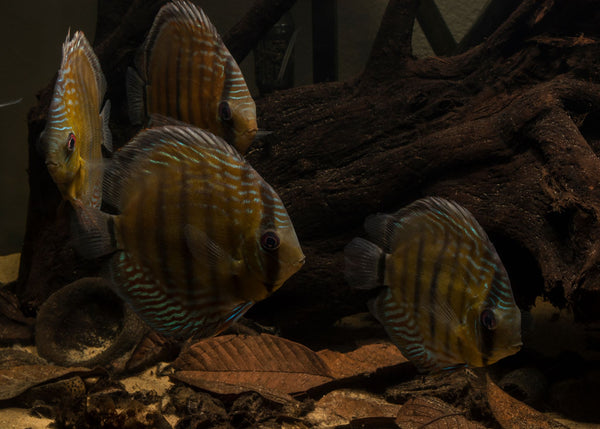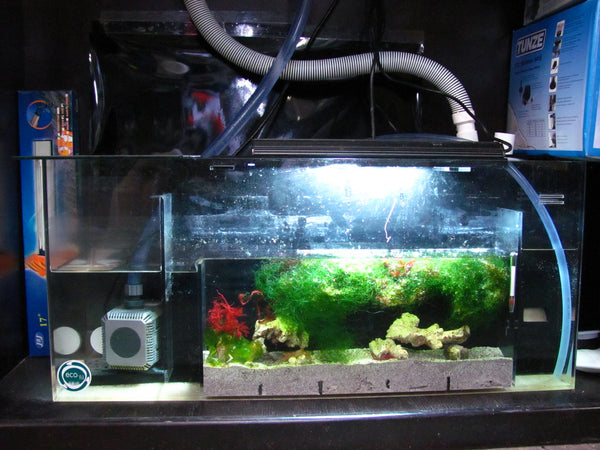- Continue Shopping
- Your Cart is Empty
Technological "crossovers" from reef keeping that can up your freshwater game!
One of the things I find both interesting and frustrating as a reefer was all the gear that we tend to use to do stuff that you'd think could be accomplished naturally in an appropriately-designed system: You know, stuff like sulphur denigrators, algae light reactors, etc., etc.

Now, I dig these gadgets, so don't get me wrong...and apparently, so does the reef keeping world, as there is no shortage of fancy gear released every month to accomplish many of the tasks that nature is supposed to! And I can't help but wonder, as we explore more naturally-functioning systems, if some of these ideas and pieces of equipment are adaptable to our purposes. Let's look at a few examples of items that might have "crossover" potential.

FLUIDIZED REACTORS: I think these are terrific for all aquariums. They essentially consist of an acrylic tube, filled with filter media (typically activated carbon or phosphate-removing media) into which water from the aquarium is fed from the bottom of the reactor up through the media and back out into the aquarium. The upward water flow tumbles the media around more-or-less-evenly inside the reactor, which permits greater contact between your the aquarium water and the media.
Now, what comes to mind immediately for me is to utilize botanicals, such as Alder, Birch, or Casuarina cones, in such a reactor, having them gently tumbled around, imparting their tannins into the water column and returned to the display aquarium. We tried this in the Innovative Marine "MiniMax" fluidized reactor that we offer on our site, and it worked great! There are numerous other reactors on the market that may be used similarly. This application is perfect for those people who, for some reason, want the tinted water and humic substances imparted by the botanicals, but don't want these items in the display itself.
Are there other uses for fluidized reactors? Yeah, I think their could be some interesting applications for cultivating food sources, like Daphnia, for example. With a gentle flow, good light, and an occasional food input, I wonder if productive remote colonies of Daphnia, Cyclops, or other aquatic crustaceans could be reliably cultured and automatically distributed into the aquarium via the reactor? Hmm.

What about making a "peat filter" or "leaf filter" out of one of these reactors? Depending upon the flow rate within the reactor, and the size of the reactor, I would think it would be possible to have enough contact time with a lot of media to impart some dentritifcation to the system, in addition to the tannins? Maybe a finer-sized material, such as our "Mixed Leaf Media" or "Fundo Tropical" could do the trick? It's probably a fine line between creating something potentially useful, or making a "hydrogen sulfide reactor", but hey- isn't that what life on "the bleeding edge" is all about?
THE REFUGIUM: We've talked about this before...Absolutely a useful concept used for decades in the reef hobby, yet somewhat out of favor currently, during the more "focused" era of coral growth versus "ecosystem development", but very, very useful! A refugium is essentially a small aquarium, set up to receive water from the display tank. It's history purpose has been to provide- literally- a refuge- for delicate animals, macro algae, or "food organisms", like copepods, amphipods, etc. For our botanical aquairums, there are numerous possibilities, including a way to grow rooted plants under intense lighting for nutrient export, the cultivation of ornamental shrimp that would otherwise be eaten, or to provide the botanical influence in an aquarium where a layer of leaves and such is not desired in the display.

Other possibilities would be to create a "remote deep leaf litter bed." This idea was suggested by John, one of our readers the other day, and I think it's brilliant! We talked about how fermentation that takes place in deep leaf litter beds in the wild contributes to a stable lower pH, and possibly to dentrification. A refugium might be an interesting starting point to experiment with? Completely filling a refugium with leaves could prove interesting! Now, I suppose if you pack leaves in too tightly, and have water flowing too slowly, the potential exists to create a large amount of hydrogen sulfide, so experimentation and caution are required when pursuing this idea. Who's up for it?
The refugium has numerous other applications, many of which we still need to experiment with. What about using it for a remote, soil-based "enrichment system", in which a reasonably deep bed (like 6"/ 15.24cm) or so is employed, perhaps with a mix of acidic soil types, peat, etc. You could create and experiment remotely with various combinations to mimic the soil compositions found in blackwater igapó, and the more alluvial-based materials found in the counterpart "whitewater" systems called várzea. I would imagine that some floating aquatic plants and some terrestrials could help with nutrient export in such a configuration...

The nice thing about a refugium is that you can take it "off line" if your experiment isn't working, or if you're having some issues...or simply if you want to run some "controls" on the setup. A lot of flexibility, and a lot of possibilities here.
You could even use a large enough refugium to prep wood? You know, those big pieces that won't stay down. Most wood, like Mopani, etc., gives off a lot of tannins during its "prep" process, so why not take advantage of this and soak the wood in a refugium attached to your display aquarium, or multiple aquariums? And, wouldn't a big old piece of wood in a refugium function much as "live rock" does in a reef tank, fostering biocover and interstitial fauna which can benefit the display? So, like a "driftwood refugium?" Yeah...cool!

With reverse daylight run in the refugium, you could conceivably counteract any day/nigh pH fluctuation, especially of you active;y grow plants or algae "down there." A lot of possibilities. You could even conceivably construct a "paludarium refugium", with a mix of terrestrial plants and aquatics in a partially submerged state, directing some water to the "land" and allowing it to "percolate" back into the water...I mean, endless possibilities for creative aquarists who are willing to try something a bit different to test out ideas about replicating things that occur in nature... Wow!
ARID REACTOR: The other piece of equipment that reefers are starting to use is the ARID reactor from a company called Pax Bellum. The acronym stands for "Algae Remediation Illuminated Device", and that's exactly what it is! This is a new twist on the old reef idea of culturing macroalage for nutrient export. Essentially, the ARID is a "typical" reactor-shaped vessel into which water from the display aquarium is distributed. The "magic" of this reactor is a central "light pole" of waterproofed LED's inside of the light-colored reaction chamber, which provides intense light to the macro algae growing inside. What makes this system unique is the ability it gives you to just slam macroalage with nutritious lighting and water from the display tank.

When I co-owned Unique Corals, we had the opportunity to play with some of the first commercial versions of these reactors in one of the coral grow-out systems in our facility before we offered them for sale, utilizing the beloved marine macroalage, Chaetomorpha, and the result were awesome! Author/aquarist Jake Adams of the popular Reef Builders blog (his pics, btw) ran some tests with them at our facility, and we were very impressed with their capability to grow this stuff! This was right about the time I was launching Tannin Aquatics, and my mind wandered off to the possibilities of utilizing this device in a freshwater setting!

Now, in a freshwater application, I can see a lot of possibilities. Certain plants that require high light levels, which may not need to be rooted, for example, would do well in such a reactor. Mosses immediately come to mind, but the intense light may not work with many of them. Experimentation would be required! Now, I would be hesitant to utilize a planted reactor like this in a low-pH, blackwater/botanical system, because the high respiration rate of the plants caused by the intense lighting could raise your pH to levels that you may not want...So, a bunch of potential issues here, particularly if you're trying to keep a very low pH system. On the other hand, what if you're trying to keep African Rift Lake cichlids, which love the high pH and could benefit from the incredible nutrient export potential and pH support capabilities of this reactor? Hello.
I see lots of potentially interesting applications for the ARID reactor in the freshwater game, including the ability to cultivate some (pricy) high-light loving aquatic plants quickly- perfect for commercial aquatic plant growers who want to do some experimentation. The door is wide open. These are not cheap devices, but the potential for incredible results is there.
Obviously, there are many other devices targeted at the marine/reef hobby sector which we as advanced, progressive freshwater hobbyists can utilize in our systems. These are just a few of the ones that come to mind at the moment, but we've talked previously about the many internal pumps, controllers, and other gear that has "crossover potential" for our work. If you have a hunch, the financial means (lol), and an urge to try something a bit out of the ordinary, go for it and apply one of these pieces of reef tech to your freshwater "game!"
Stay inventive. Stay progressive. Stay fearless. Stay well-financed!
And Stay Wet.
Scott Fellman
Tannin Aquatics
2 Responses
Scott Fellman
Thanks, Joni! I am glad that you enjoy the posts…It’s so important- now more than ever, with all of the access to information and technology that we have- to push beyond the “rules” that have been laid out and accepted as “gospel” for so long. Many of them are on-point, and perfectly acceptable for what we do as hobbyists. Others reflect antiquated notions, or are indicative of ideas which were not fully thought out…Sometimes, it just takes a different perspective to create entirely new ways of doing things…more successfully than previously though possible. Open minds wanted. :)
Joni
Scott, I enjoy your posts because you are so open to to new ideas or rethinking old ideas in new ways!













Scott Fellman
Author